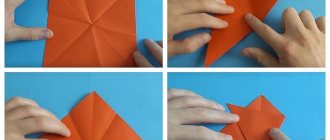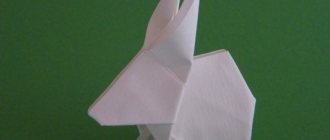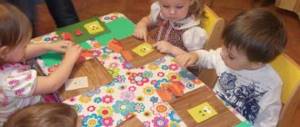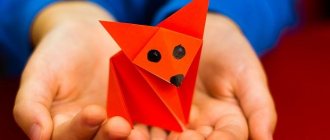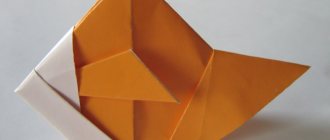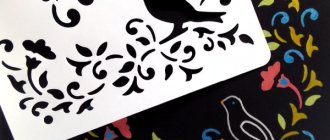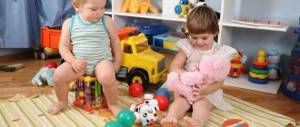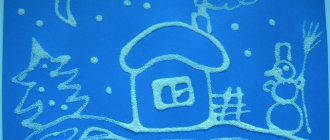Games
For children in kindergarten, preschoolers and schoolchildren, various games with Cuisenaire sticks have been developed, from the simplest to the more complex.
Games for kids 1 – 2 years old
Children can only work with this manual under adult supervision, as there are small parts. Home comfort and familiar surroundings contribute to the development of new activities. Already at one year old, children can play with them, look at colors, and the adult’s task is to give comments about length, color, height, quantity.
"Builder". Invite your child to look at the building materials, take as many blocks as possible in one hand, then transfer them to the other. So the child's hand will begin to feel the difference in size and quantity. Build a road, house, bridge, tree, well, transport with your child.
"Sorter." You can take colored cardboard and invite your child to sort the sticks by color. You need to put all the red ones on the red sheet, and all the yellow ones on the yellow sheet.
"Up the stairs." Assemble the ladder from the white to the yellow stick. Take a small toy, such as a bunny, and let him jump up the stairs. At the same time, count “The bunny jumps again, one, two, three, four, five.” Then you can assemble a ladder higher, and count to 10. When the child has mastered this game, you can skip the steps (the ladder is broken) so that the child puts them in place (repairs the ladder).
"Do as I do". Show the child a blue stick in your hand and ask him to take the same one. Take two sticks and have him repeat. Make the roof of the house out of them. The essence of the game is that the child learns to correlate what you show and do the same. You can hum a song before each new demonstration and repetition, “trawl-la-la, trawl-la-la, do Mishenka (your child’s name) like me!” You can use the mirror method on paper. An image is drawn on one half, and the child must complete the second half using a template.
"Colored fence" Lay out two colored sticks, then again two of the same. Say that you are painting the fence blue and orange, and invite your child to continue the fence. Then you can complicate it by adding a number of colors, building more complex sequences. For example, blue, white, pink, yellow. Let the child post more.
"Elusive." Play with the sticks as if they were living characters, say that now they will run away, change places, hide. Lay out five sticks, and then, while playing with them, hide one behind your back or next to the box. Ask your child which stick disappeared? Where did she go? Let him find her. You can also swap them, red was the first. Place it in the middle. Where did she go? This game develops attentiveness and trains memory.
"Train". Build a train with carriages of different lengths using sticks. Name colors and sizes. Ask which carriage is the longest, what does it carry? Maybe logs for the house. What is the smallest carriage that can carry? Maybe apples. How many cars are there at the station? How many have gone, how many are left? During this game, the child learns the concepts of “long”, “short”, “big”, “small”, “one”, “many”. To complicate the game, you can ask which car is to the right of the red one, to the left of the yellow one.
Tasks for children 3 – 4 years old
Older children at 3-4 years old can already learn simple counting and repeat games from the previous stage, but with a little more complexity. This is important at the stage of entering kindergarten, because there they also give educational tasks, and perseverance is required. Here are some new games that can be offered at this age.
"Figure Outline" . Draw geometric shapes on paper or print them out, ask your child to draw its outline with sticks and name the shape. Show yourself how to lay out a square, triangle, rhombus. You can also make labyrinths out of them. The resulting path can be completed with the help of small toys and cars.
"The Stick Story" First, lay out the story yourself with chopsticks, then ask your child to do it. Lay out a long stick (dad decided to build a house, made a foundation), put two perpendicularly along the edges (put walls), on top two more at an angle upward (made a roof). It turned out to be a great house, but without windows and doors. Make a window and a door from small blocks. This task develops oral speech very well. Make sure that the logic of presentation is followed.
"Guess which one . Hide the stick in your fist and say that you are holding the one that is larger than pink but smaller than red. What stick is in your fist? Blue, that's right! Keep playing by asking questions like these.
“Color with sticks . You can purchase ready-made albums, or print out drawing diagrams yourself in order to color them with sticks. For example, you printed a hare. Let the child choose the appropriate length elements for the ears, paws, and tail. And you say the ears are long, the tail is short. You can also recite a poem with the theme of the picture “A bunny jumped on the lawn, a long-eared, colored bunny.” You must show the algorithm of actions so that the child can repeat it.
Tasks for children 5 – 6 years old
Preschool age 5–6 years is optimal for introducing new tasks, as active preparation for school is underway. Tasks should lie in the zone of proximal development. Study the Federal State Educational Standard (federal state educational standard), see what skills a child should have, and practice in the game those skills that will be useful in elementary school.
"Who is faster" . You name the number, the preschooler must pick up the stick that corresponds to this number faster than you. Also, on the contrary, you take a stick, raise it up, and his task is to quickly say the number that corresponds to it.
"Exceptions" . We offer a set of tasks for exceptions, for example, “Give me one that is neither blue nor red,” “give me a stick shorter than the burgundy one, but longer than the pink one,” “choose two sticks that will not make the same length as the yellow one.” There are many options for such exception tasks. We recommend that you first make a list for yourself and write down the correct answers on paper so that you don’t get confused later.
"Simple Examples" . Show that two white sticks form one pink one. And pink and white are equal to blue. You can label the numbers on the sticks to start making associations between writing the numbers and the color/size. Let’s do problems like this: “how many white sticks must be added to the blue one to make blue?”
"With eyes closed" . Set the condition to determine the color of the stick, using only your fingers, with your eyes closed. Explain that the smallest stick is 1 cm, about the width of a finger. Teach your child to measure the distance of sticks using their fingers. You can hang a bell and ring it as many times as the number of the pulled out stick corresponds to.
Tasks for children 7 – 9 years old
The school continues to improve the skills acquired earlier. At the age of 6–7 years, discipline appears and the student’s readiness to solve more complex problems that require more attention and perseverance. It’s good when tasks overlap with the school curriculum during this period or even slightly overtake it.
"Part and Whole" . A lesson on fractions can be fun. Put down an orange stick and say that it is whole, but consists of two parts (put two yellow sticks). Just like 10 consists of 5 and another 5. Five is ½ of ten, which means half. Place sticks of the same length in front of you and the child. For speed, find two other sticks so that together they are the same length as the first. For example, nine can be made in several ways from two and seven, from one and eight, from five and four, from three and six.
"Make a number" . Offer the student the following exercise on number composition. There are ten sticks, but you can add any number from them. Orange and white are eleven. Two orange is twenty. Show your child this pattern, let him make up 15, 22 and other numbers.
“Solve an example . Use cardboard numbers and signs to lay out an example. The child’s task is to use sticks to show a visual solution to this example. Let's say you put 2+3 = The child must put pink, blue and yellow sticks. Then give an oral report on why he chose these particular colors.
The benefits of counting sticks in the mathematical development of preschool children
It is a mistake to think that with the help of these improvised means you can teach a child to count, and nothing more. Their task, in the capable hands of parents, is to develop children's thinking, namely:
- They help to learn colors, fold and study geometric shapes, design intricate castles, and solve logic problems. Therefore, counting sticks can be an excellent teaching aid when organizing home activities.
- With the help of this simple and multifunctional textbook, you can study the order of numbers and their composition, the concepts of “shorter-longer”, “more-less”, “higher-lower”.
- It is also worth listening to the opinion of psychologists who simply insist that, along with fine motor skills, games and activities with these counting elements help develop in a preschooler:
- intelligence;
- independence;
- imagination and creative thinking;
- attention;
- interest in research and knowledge;
- activity;
- the will to win;
- determination;
- persistence;
- independence;
- ability to plan, control and evaluate one’s own activities;
- concentration.

